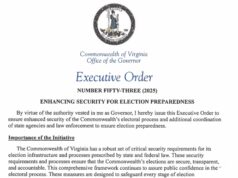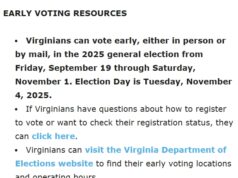by Delegates Mark Levine (D-HD45) and Lamont Bagby (D-HD74)
Do you know what’s on your ballot this fall? After voting for president and members of Congress, you will see two proposed amendments to the Virginia Constitution. For Amendment 1, you will be asked a complicated question that masks an even more convoluted proposal.
Have you read the full amendment? Very few Virginians have. But before you make a permanent change to the foundational structure of Virginia law, you should. As a recent lawsuit explained, the question on the ballot does not come close to adequately explaining it.
Simply put, Amendment 1 enshrines the odious practice of gerrymandering into our Constitution and makes it virtually impossible to remove.
Gerrymandering — drawing district lines to favor a particular political party — is as old as the republic. Patrick Henry tried and failed to gerrymander James Madison out of the first Congress. District boundaries were designed to prevent descendants of enslaved Virginians from casting ballots for representatives of their choice. And just last year, the United States Supreme Court ruled federal courts have no power to stop it.
But states can stop gerrymandering. The recipe is clear. We must change two things: “how” you draw district lines and “who” draws those lines.
First, the “how.” We need rules that ensure fairness; protect racial/ethnic minorities and other communities of interest; require compact and contiguous districts; and, above all, not unduly favor any political party.
Second, the “who.” We need a nonpartisan commission, independent of the Virginia legislature, drawing the lines. Voters should choose who represents them; not the other way around.
By these two measures, Amendment 1 is a giant step backward. First of all, it allows unlimited gerrymandering. You would think a so-called “reform” measure would at least bar line drawers from overwhelmingly favoring a single political party. Not this one. Amendment 1 allows 60% of Virginia’s population to be represented by a minority of legislative seats. That alone should cause you to scratch your head. Furthermore, there are scant protections for racial and ethnic minorities.
That’s not even the worst part. Even worse than the “how” is the “who.” The amendment expressly gives the four legislative party leaders power to populate the entire commission with their own appointees, including close friends and family members. Independents and third parties would have zero representation.
And if just two legislators object, the entire process is thrown to a panel of judges appointed by the very legislature whose district lines they are designing. One judge could draw district lines for her own brother, a sitting senator. See a conflict here? We do.
It might seem strange to hear two legislators argue the case against legislative gerrymandering, but we both have long been fighting for nonpartisan redistricting reform. And we just don’t think letting legislators draw their own districts without guardrails is reform. Some so-called reformists (and the Texas billionaires who’ve spent millions to fund them) say this flawed proposal is the best Virginia can get. But we know we can do better.
The good news is we already have. In fact, we are halfway there.
This year with little fanfare, the Virginia General Assembly did something extraordinary. We banned gerrymandering. On a party-line vote, we became the first legislature in the nation to solve the “how” problem completely. House Bill 1255 and Senate Bill 717 fully protect communities of interest and racial and ethnic minorities.
Most importantly, the new law prohibits the drawing of district lines from unduly favoring any political party. And this is already the law for the 2021 redistricting, unless it is overruled by Virginia voters deceived into voting for Amendment 1.
But that’s not all, folks. We can solve the “who” problem, too. Today, the vast majority of Democrats in the General Assembly are on record, committed to enacting a true independent redistricting commission in 2021: one where voters pick legislators and not the other way around. We are not your parents’ Democratic party.
And the best news is — if Amendment 1 is defeated — Republicans will have to join us. Faced with the prospect of redistricting by either (a) a fair independent commission or (b) majority Democrats, we are confident the GOP will join us in preferring option (a).
Amendment 1 was designed at the 11th hour on the last day of the 2019 session to put a finger on the GOP scale in the face of impending Democratic majorities. But once Amendment 1 is off the table, the independent commission we have long dreamed of can finally become a bipartisan reality.
We can do this. But only if we don’t enshrine gerrymandering permanently in the Virginia Constitution. When you cast your ballot, go beyond the convoluted ballot question. Don’t believe the hype. Read Amendment 1 carefully. Understand it fully. See how it keeps party leaders in control and allows unlimited gerrymandering. Then vote “no.”













